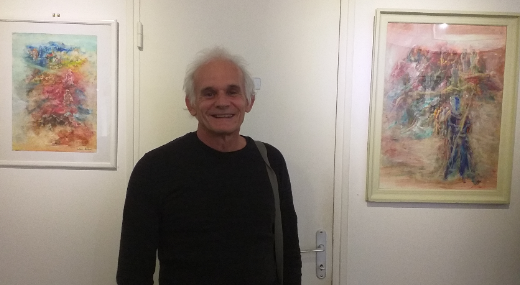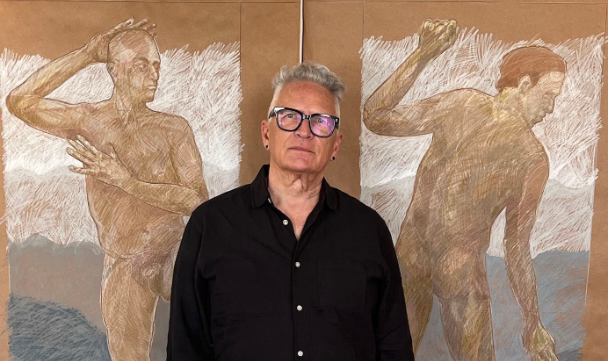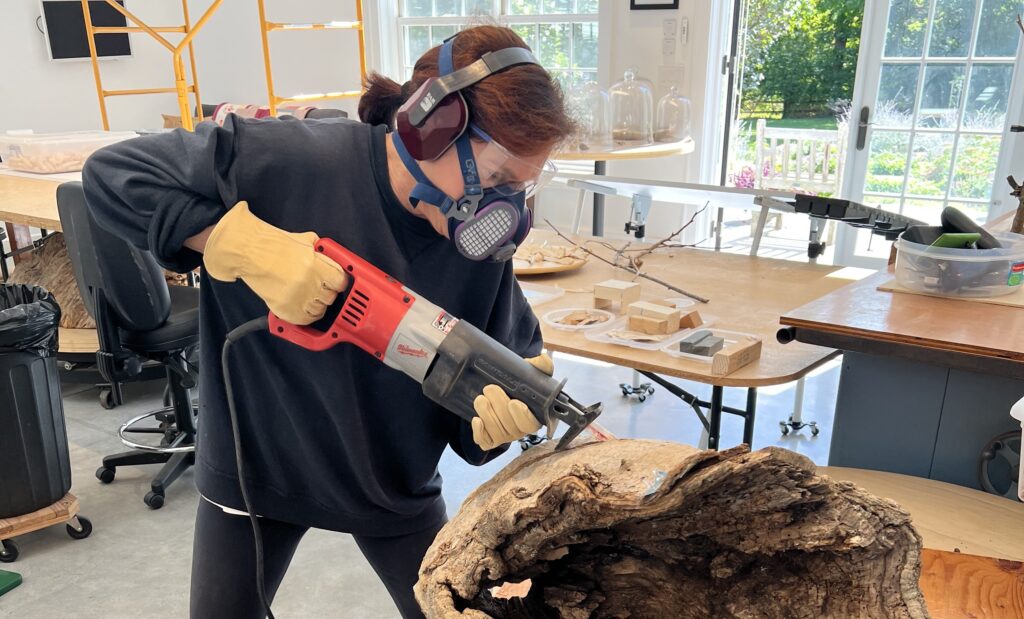
Seeking the Light, Bound to the Earth
by/di Till Bögelsack (traduzione in italiano al fondo pagina)
The wind carries thoughts. They seem like the notes of a flute announcing the arrival of spring. Tiny spring leaves and purple crocus flowers announce themselves on the forest floor. They are signs of hidden growth. Donna Forma’s sculptures, complementary parts that form a whole, are like a natural foundation or a natural philosophy, with hidden depths waiting to be discovered.
Deep within the sculptures, we assume, are hidden layers of meaning. The outer shell hides the uncertainty of what lies within the form, yet the sculptures appear vulnerable even from the outside. If we look closely, we see the naturalness of Donna Forma’s sculptures. We find an embrace of the form and the variability of the materials.
Physicality is palpable in all the materials. When we approach Donna Forma’s art, we want to explore the different layers like a geologist explores geological strata; they resemble the layers of a beehive. And the agricultural, earthy context is always present.
But with each layer we find great strength, a backbone of earthy solidity that allows for natural resilience. Not rock and not water. Layers add strength, they add solidity, and in works of art they become a pillar for the growth of the mind and imagination. Thoughts find themselves in the contemplation of meaning, flowing upward, building on a solid foundation for wheat fields to grow. Donna Forma’s work conveys a sense of upward striving, of transcendence woven into the artwork.
In her work, we take the perspective of the earthbound, perhaps purple lavender fields as we look upward to the sky. We inhale the pleasant scent as we paint in the warm Provençal sun. It is, or seems to us, like elements rooted in the earth, reaching for the light, bound to the matter and clay of the earth, but spiritually connected to the greater sphere above.
Metaphorically, we imagine a field of lavender, a female form within the sculpture itself, meeting the sky as we look out over the Provençal landscape. Where the earth meets the sky above, we are surrounded by fields of lavender and a lavish form of earthly grace.
We are surrounded by branches, embracing and tugging, in a state of relaxation. We enter the meditative flow of the earth. Peace and relaxation roll over us like waves of Provencal lavender fields, allowing us to reach upward in our spiritual imagination. The sculptures allow us to imagine lavender fields on rolling hills, soft summer sunshine and blue canopy all around us. The iron-rich earth appears round, like a red pomegranate.
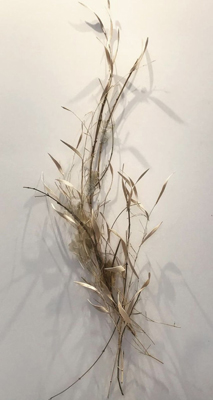
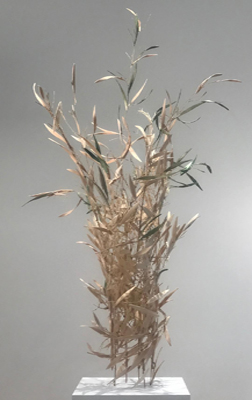
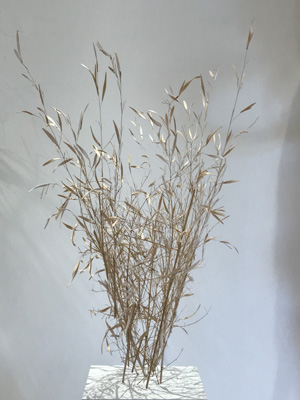
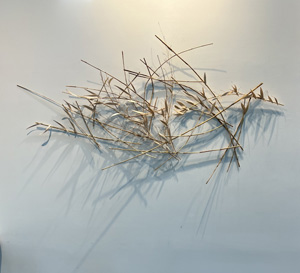
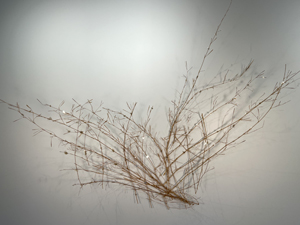
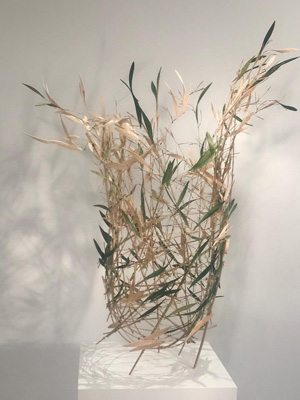
Artwork: Seeking the light, bound to the earth
Physicality amid the infinite
Everything passes; time passes. But there is artistic creation. Everything comes together in the form of waves. It is like a wave in a field of lavender. We imagine ourselves in a field of lavender, with a nourishing scent, purple shapes, full of life, revealing new thoughts of connection between the human plain and the deep blue sky above.
There is a refreshing spread of life, life in every lavender flower and stem, just as there is life in every grain of wheat. The lavender flower has leaves of wisdom and every grain of wheat has nourishment. And the lavender stem, a sturdy pillar of knowledge gathered from within nature and natural reverence beyond. And natural reverence can feel infinite, in the pleasant scent of bakhoor and sandalwood.
And the infinite is even more powerful and revealing in fragile form. It is found in the organic flow of Donna Forma’s artwork, quoting Donna Forma: “The sculptures are made of hundreds of fragile parts that are manipulated, cut, formed, drilled, sewn, wired, lashed, strapped, slashed or layers woven tightly together creating a high tensile strength, working in and out, through and around, up and down, establishing a beautiful order until the form has been determined.”
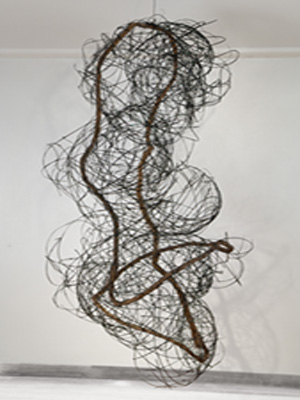
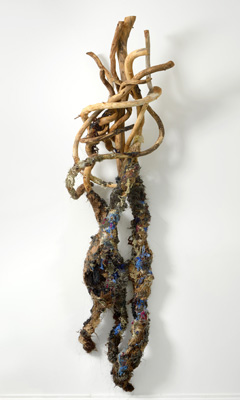
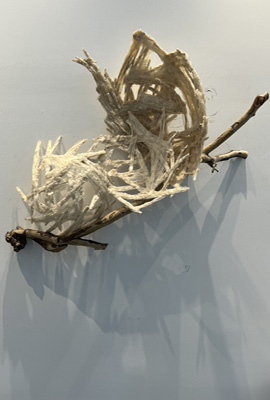
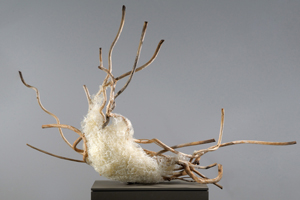
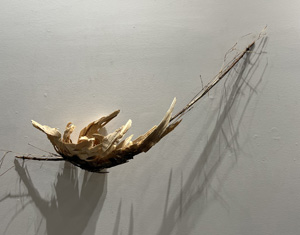
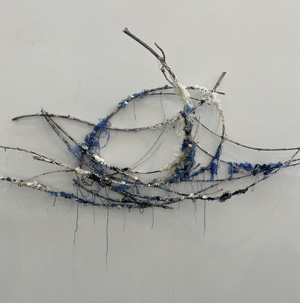
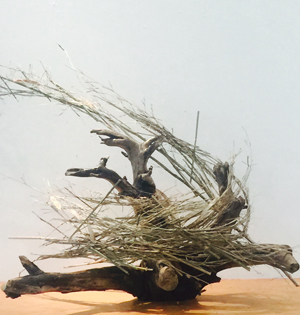
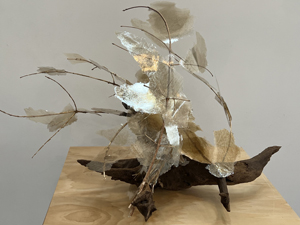
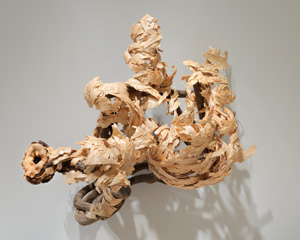
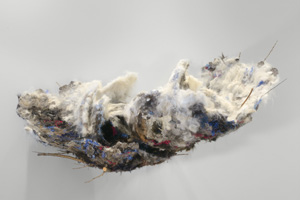
Artwork: Physicality amid the infinite
Caring for the land and the city
Donna Forma’s work may symbolize an organic bridge we create in our minds between the land (rural) and the city (urban). This may be a symbol of modernity, we may wish to return to the natural sphere to relax and meditate, almost as if wrapped in the smoke of frankincense, in a meditative state to see environmental concerns in a new light.
The nurturing (feminine) that symbolizes the land and the city (masculine). Together the unity of form is like a Greek Agora or Acropolis. Imagine an acropolis as a beehive of gathered knowledge, each of us like bees making a unique contribution to the power of knowledge and thought. This is a natural metaphor.
Each one of Donna Forma’s beehives is like a meeting place of shared minds grafting together a cohesive conversation. The bound form is symbolic of the Agora and the Acropolis. All this, every uplifting conversation is a meeting place of nourishing discussion.
In conversation, complementarity and coming together, as if we were looking for purple lavender flowers and saffron to express our inner essence.
This can lead to artistic insight; we find the vulnerability of organic form. Organic sculptures are also delicate, like ancient texts with hidden messages, quoting Donna Forma: “These shelters or hives are in a sense metaphors of life. You and I become the insect constructing the cocoon, never knowing if it provides safety or danger.“ Her art is informed by vulnerability and multifaceted identity.
There is an approach to read inner nature in the most subliminal way, swaying with our hands through the lavender fields, sparrows flying far above, and we allow ourselves to be down to earth and flow in the lavender fields like a painter painting with acrylic.
Donna Forma’s sculptures allow us to feel grounded in our personal identity and to enter a contemplative peace. Her sculptures allow us to see and reflect on our human frailty as part of nature and beyond. We seek greater humility. We see human frailty not only in nature’s art, but through nature we come to see frailty in ourselves.
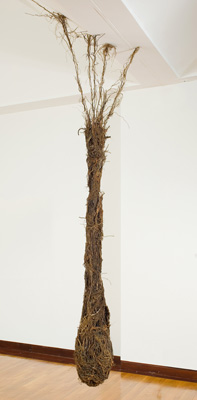

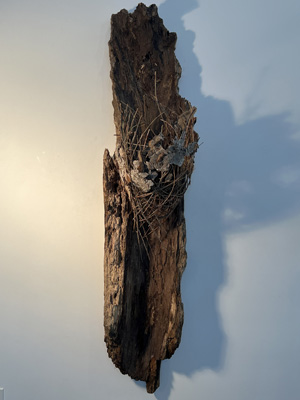
Artworks: Caring for the land and the city
Layers of meaning
In conversation, we add new layers of meaning to the core of our original thoughts, like tree rings. Each new layer of meaning is grafted onto the substrate like the rocks that join to form a mountain. Resin is like connective tissue, like the ferns that bind the subsoil of the forest or the neural networks of our brain. It not only makes the structure more flexible and resilient but also adds sublime beauty and nuance.
The whole structure seems to have emerged naturally, and it feels as if layers have been added without human effort. The form simply flows with natural grace and seems to be in a state of flux. The structural organicity is a natural flow, and the flow comes as easily to the viewer as listening to a Vivaldi symphony. There is a sculptor’s melody.
Imagine Vivaldi’s winter melody played on a flute in the Winter Palace, surrounded by snow and enveloped in the scent of amber. The outer wall of a beehive encapsulates the inner life. The bees rest in the structure itself, and outside the snow is falling. Outside, a cold wind blows from the Alps into the lavender fields of warm Provence.
In winter, the bees thrive in company, reveling in the stories of the warm summer, when they pollinated the lavender fields in search of the purple flowers, or searched for nectar in the purple fields of saffron. With the first rays of sunlight, the bees prepare for spring. They find honey. And for the bees, honey is the glue that holds them together. It is like cinnamon that soothes the heart.
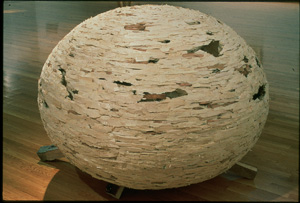
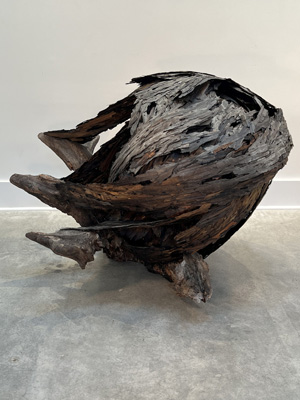
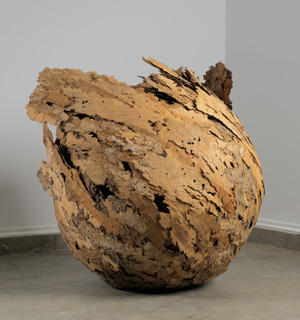
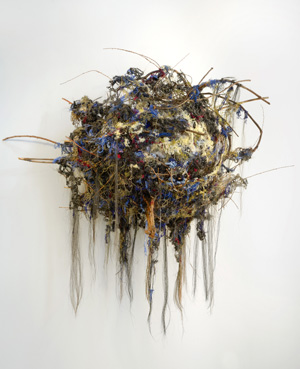
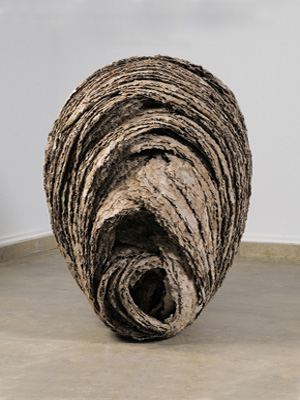
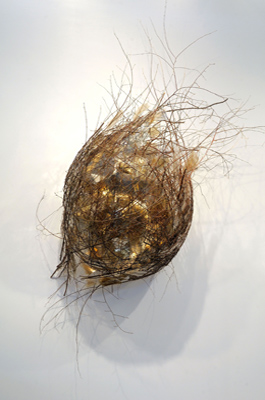
Artworks (04): Layers of meaning
Conclusion: The freedom to live in between
Donna Forma is a strong artistic voice in the arts that addresses complementarity through an exclusive focus on natural form, exploring the complementarities and complementary sides of our earthly nature. We are connected to the earth in so many ways, yet we seek fulfillment as part of what is beyond ourselves. We all come together as a whole. The sparrow’s nest or honeybee hive speaks to this complementarity of nature, as it is in balance between heaven and earth, with both the bees and the sparrow in the air above.
Complementarity is also an important artistic theme in the discourse of art. It opens canonical artistic perspectives, concepts such as earth and sky, rural and urban, femininity and masculinity, order and disorder, and industrialization and post-industrialization, and has broader implications for the world outside the arts and in speculation about how the post-industrial landscape might seemingly dissolve into nature, giving way to a spirit of inner growth and community.
The natural, papyrus-like layers of the beehive reflect a deep human connection and can take us beyond nature into a historical awareness of what can be lost, contrasting the past with the present, a sense and feeling of ancient codes held in her delicate work like lost texts from the great Library of Alexandria.
It is the interplay of each of these perspectives that makes her work so exciting for the viewer. But all the works form a whole, like a symphony orchestra played by many. In her work we see a reflection of the core ideas of art in the 21st century, as identity seeks complementarity, as new connections are sought, and as ideas merge to build bridges to create togetherness and understanding, and naturalness and peace-seeking. The freedom to live in between.
For the exhibit at Museum Mile Contemporary showcasing the art portfolio of Donna Forma
Museum Mile Contemporary is a non-profit institution founded by Pamela Goldman
To send a message to the artists or the administration click the link:
https://www.museummilecontemporary.org
To contact the Author of this review: tlbgls@proton.me
To contact Donna Forma directly:
Email: donnaforma@aol.com
Website: https://www.donnaforma.com/
Video: https://www.instagram.com/share/BAHQ4wosHj
*°*°*
Traduzione in italiano
di Simona Maria Frigerio
Esposizione di Donna Forma al Museum Mile Contemporary
Cercando la Luce, vincolati alla Terra
Il vento reca pensieri. Paiono note di un flauto che annunci la primavera. Minuscole foglie e crochi purpurei si rivelano sul suolo della foresta. Sono i segnali di una crescita nascosta. Le sculture di Donna Forma, parti complementari che creano un tutt’uno, sono come fondamenta umane o una filosofia naturale, con profondità celate che attendono di essere scoperte.
Nella parte più intima delle sculture presumiamo strati nascosti di senso. L’involucro esteriore cela l’incerto che giace nella forma, eppure le sculture appaiono vulnerabili anche dall’esterno. Se osserviamo più da vicino, notiamo la loro naturalezza. Scopriamo l’abbraccio della forma e la variabilità dei materiali.
La fisicità è palpabile in tutti i materiali. Quando ci avviciniamo all’arte di Donna Forma, vogliamo esplorare i differenti strati come fa un geologo con quelli del terreno: assomigliano agli strati di un alveare. Il contesto rurale, legato alla terra, è sempre presente.
Ma con ogni strato troviamo una grande forza, una spina dorsale di solidità terrena che permette la resilienza naturale. Né roccia né acqua. Strati aggiungono forza, solidità, e nelle opere d’arte diventano un pilastro per la crescita intellettuale e immaginativa. I pensieri si ritrovano nella contemplazione del significato, fluenti verso l’alto, edificando su solide fondamenta affinché crescano campi di grano. Il lavoro di Donna Forma trasmette un anelito verso la trascendenza, intessuta nella sua trama.
La nostra prospettiva, grazie ai suoi lavori, ci lega alla terra: campi di lavanda violacea mentre osserviamo il cielo. Inaliamo il piacevole aroma mentre dipingiamo nel tiepido sole provenzale. O così ci sembra. Come se gli elementi fossero radicati nel terreno, in cerca della luce, legati alla materia e alla creta terrena, ma connessi spiritualmente all’immensa sfera sopra di noi.
Metaforicamente, immaginiamo un campo di lavanda, una forma muliebre nelle sculture, che incontra il cielo mentre sorvoliamo con lo sguardo il panorama provenzale. Là dove la terra incontra il cielo sovrastante, siamo circondati da campi di lavanda e da una prodiga forma di grazia terrena.
Intorno a noi rami, che abbracciano e strattonano, in uno stato di rilassamento. Entriamo nel flusso meditativo terrestre. La pace e il relax ci investono come le onde di un campo di lavanda, permettendoci di arrivare più in alto nella nostra immaginazione spirituale. Le sculture ci consentono di immaginare campi di lavanda su ondulate colline, il tenue sole estivo e l’azzurra chioma tutt’intorno a noi. Il terreno ferroso ci appare d’intorno come una rossa melagrana.
Fisicamente al centro dell’infinito
Ogni cosa passa; il tempo passa. Ma vi è la creazione artistica. Ogni cosa si riunisce in forma di onde. Come un’onda in un campo di lavanda. Ci immaginiamo di trovarci lì, con un aroma che nutre, forme violacee, piene di vita, che rivelano nuovi pensieri di connessione tra la piana umana e il cielo azzurro intenso sovrastante.
Vi è una vita che si diffonde tonificando, la vita in ogni fiore di lavanda, come in ogni chicco di grano. Il fiore della lavanda ha foglie di saggezza e, come ogni chicco di grano, nutre. E il fusto della lavannda, un pilastro robusto di sapere raccolto in natura, va oltre la reverenza naturale. Quest’ultima può parere infinita, nella fragranza piacevole dei mattoncini di incenso e nel legno di sandalo.
L’infinito è persino più potente e rivelatore in forme fragili. Si ritrova nel flusso organico della creazione artistica di Donna Forma, come spiega lei stessa: “Le sculture sono fatte di centinaia di parti fragili: lavorate, tagliate, a cui dò forma, trapano, cucio, collego, lego, fisso, taglio o tesso strettamente creando una tensione elastica, lavorando dentro e fuori, attraverso e intorno, sotto e sopra, stabilendo un ordine di bellezza finché la forma non si determina”.
Tenendo alla terra e alla città
Il lavoro di Donna Forma può simbolizzare un ponte organico che creiamo nelle nostre menti tra la terra (rurale) e la città (urbana). Può essere un simbolo di modernità, potremmo voler tornare alla sfera naturale di rilassamento e meditazione, quasi fossimo avviluppati nel fumo dell’incenso, in uno stato meditativo, sì da vedere le preoccupazioni per l’ambiente sotto una nuova luce.
Il nutrimento (femminino) che simbolizza la terra e la città (mascolino). Insieme, l’unità di forma come nell’Agorà o nell’Acropoli greca. Immaginate l’Acropoli come un alveare di sapere raccolto: ognuno di noi come un’ape che sta fornendo il suo contributo unico al potere del sapere e del pensiero. Questa è una metafora naturale.
Ogni alveare di Donna Forma è come uno spazio d’incontro di menti condivise che si riuniscono per una conversazione coesiva. La forma del legame è simbolica, come nell’Agorà e nell’Acropoli. Tutto ciò, ogni conversazione che ci eleva, è uno spazio adatto a una discussione che nutre.
Nella conversazione, la complementarietà e il venirsi incontro sono come la ricerca di fiori di lavanda violacei e zafferano per esprimere la nostra più intima essenza.
Possono condurre all’intuizione artistica. Vi ritroviamo la vulnerabilità della forma organica. Sculture con tali elementi sono anche delicate, come testi antichi con messaggi nascosti. Donna Forma spiega: “Questi nascondigli o alveari in un certo senso sono metafore della vita. Tu e io diventiamo insetti che costruiscono un bozzolo, senza sapere se fornirà protezione o sarà un pericolo”. La sua arte si fonda su vulnerabilità e identità multisfaccettata.
Vi è un approccio a leggere la natura interiore nel modo più subliminale, oscillando con le nostre mani attraverso campi di lavanda, i passeri che volano al di sopra, e noi che ci permettiamo di stare sulla terra e fluire nei campi di lavanda come un pittore che dipinga con colori acrilici.
Le sculture di Donna Forma ci permettono di sentirci piantati a terra nella nostra identità personale e di accedere alla pace contemplativa. Le sue sculture ci permettono di vedere la e riflettere sulla nostra fragilità umana come parte della natura e oltre. Cerchiamo maggiore umiltà. Vediamo la fragilità umana non solo nell’arte della natura ma, attraverso la natura, vediamo la fragilità in noi stessi.
Strati di significato
Nella conversazione, aggiungiamo nuovi strati di significato al nocciolo dei nostri pensieri originali, come anelli di un tronco d’albero. Ogni strato si innesta nel substrato come rocce che si uniscano a formare una montagna. La resina è come tessuto connettivo, come felci che fasciano il sottosuolo della foresta o le reti neurali del nostro cervello. Non solo rende la struttura più flessibile e resiliente ma aggiunge bellezza sublime e sfumature.
L’intera struttura sembra essere emersa naturalmente, come se gli strati fossero stati aggiunti senza sforzo umano. La forma semplicemente fluisce con grazia naturale e pare in uno stato fluttuante. L’organicità strutturale è un flusso naturale, che scorre con facilità verso l’osservatore il quale ascolta una sinfonia di Vivaldi. Vi è melodia nella scultura.
Immaginate l’Inverno di Vivaldi suonato da un flauto nel Palazzo d’Inverno, circondati dalla neve e avviluppati in una fragranza di ambra. Il muro esterno di un alveare incapsula la vita interiore. Le api riposano nella stessa struttura, e al di fuori scende la neve. Fuori un vento freddo soffia dalle Alpi sui campi di lavanda della tiepida Provenza.
In inverno, le api prosperano in compagnia, godendosi i racconti della tiepida estate, quando hanno impollinato i campi di lavanda in cerca dei fiori violacei, per il nettare dei campi di zafferano. Coi primi raggi di sole, le api si preparano per la primavera. Trovano il miele. E per le api, il miele è il collante che le tiene insieme. È come la cannella che allieva il cuore.
Conclusione: la libertà di vivere in mezzo
Donna Forma è una potente voce artistica che si rivolge alla complementarietà attraverso un focus esclusivo sulla forma naturale, esplorando le complementarietà della nostra natura terrena. Siamo connessi alla terra in così tanti modi, eppure cerchiamo la realizzazione come qualcosa al di là di noi stessi. Siamo parte di un tutto. Il nido di passero o un alveare ci parlano di questa complementarietà della natura, in equilibrio tra cielo e terra, con le api e i passeri nel cielo sopra di noi.
La complementarietà è un tema artistico importante. Apre prospettive canoniche, concetti come la terra e il cielo, rurale e urbano, femminino e mascolino, ordine e disordine, industrializzazione e post-industrializzazione, e ha implicazioni più ampie per il mondo al di fuori delle arti e nella speculazione su come il paesaggio post-industriale potrebbe dissolversi nella natura, cedendo il passo a uno spirito di crescita interiore e comunità.
Gli strati naturali, simili a papiri, di un alveare riflettono una connessione umana profonda e ci portano al di là della natura in una consapevolezza storica di ciò che si può perdere, contrastando il passato con il presente; un senso e un sentimento di antichi codici sono racchiusi nel suo delicato lavoro come testi perduti della Biblioteca di Alessandria.
Il gioco tra tutte queste prospettive rende il suo lavoro così eccitante per l’osservatore. Ma le opere formano un tutto, come un’orchestra sinfonica con molteplici elementi. Nel suo lavoro vediamo il riflesso del nocciolo delle idee sull’arte del XXI° secolo, dato che l’identità cerca la complementarietà come si cercano nuove connessioni, e come le idee si mescolano per costruire ponti e creare unità e comprensione, naturalezza e mantenimento della pace. La libertà di vivere in mezzo.
Per le esposizioni del Museum Mile Contemporary. In mostra, il portfolio artistico di Donna Forma
Museum Mile Contemporary è una istituzione non-profit fondata da Pamela Goldman
Per inviare un messagglio all’artista o all’amministratore cliccare su:
https://www.museummilecontemporary.org
Per contattare l’Autore di questa recensione: tlbgls@proton.me
Per contattare Donna Forma direttamente:
Email: donnaforma@aol.com
Website: https://www.donnaforma.com/
Video: https://www.instagram.com/share/BAHQ4wosHj
Friday, March 7, 2025 / Venerdì, 7 marzo 2025
On the cover: a portrait of the artist; in the article: all images, courtesy by the artist ©Donna Forma (all rights reserved. Reproduction prohibited) / In copertina: un ritratto dell’artista; nell’articolo: tutte le immagini, courtesy l’artista ©Donna Forma (tutti i diritti riservati. Vietata la riproduzione)





